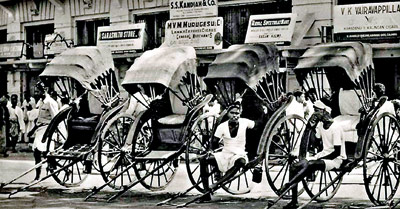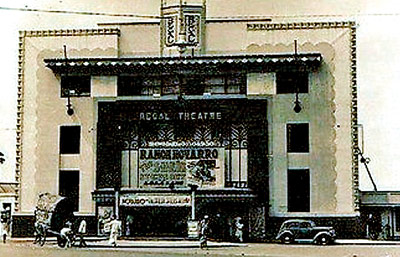Come with me to 1930s’ Colombo
View(s):As the country prepares to mark its 68th anniversary of Independence from colonial rule, Tissa Devendra sifts through his rag-bag of memories to life in pre-Independence days……

Rickshawmen in Colombo: Picture probably from the early 1940s by Ceylon Pictorials. Pix courtesy www.thearchives.lk & https://web.facebook.com/thearchivesl
This memory goes back to the mid-1930s when we lived in Maradana, and I was just learning my ‘abc’ in Nalanda’s ‘Baby Class’.
Our neighbours next door were a bachelor establishment whose man-for-all-seasons was Simon, a youth from a distant village. He was determined to improve his lot by learning English.
With this end in view he had enrolled in a Free Night School. This was one of the voluntary institutions, usually conducted in a temple ‘Bana Maduwa’ and staffed, I believe, by idealistic young law students and junior clerks. They were run by the local Pansala to attract youth to be ‘dayakas’.
Their students were drawn from a ‘target group’ composed of chauffeurs (then called ‘drivers’), servant boys (now ‘domestic aides’) and assorted male employees of local shops.
Classes were held in the early night when the chores of these students were over and they were free to attend. These classes used graded text books, roughly printed with clumsy illustrations, boasting such titles as “Simple English for Beginners” .
Students were expected to bring their own exercise books and pencils (ball point pens were not yet invented and fountain pens were an expensive luxury) to laboriously scrawl their home-work.
This is where my childhood self came into contact with Night Schools. Simon next door saw that I was studying in English, the language of all secondary schools, and persuaded, barely literate me to tutor him in his homework.
It was a fascinating experience to be ‘teaching’ a much older chap. These classes went on for a year or so – till we left to settle down in Kandy.
I wonder whatever happened to these pioneer Night Schools which were a bold attempt at Adult Education by well meaning volunteers – long before it became the plaything of educational panjandrums. I wonder whether it is too late for sociological researchers to rediscover this ‘slice of urban life’.
House beautiful
Paint was only used for doors and windows. House walls, generally before Sinhala Avurudu, were whitewashed. The white washer came equipped with the tools of his trade – big buckets sloshing with chunam based whitewash, broad paint brushes, bamboo ladder, a slim pole topped with tufts of coir and a pail of acrid smelling black tar. Children had a good time slathering whitewash on a foot or two of wall, watched tolerantly by the worker.
Bed sheets and assorted old sarongs covered the furniture when whitewashing was done within the house. The final touch was when the tar was heated and a broad black border was painted along the bottom of all indoor walls – as a termite repellent. That was all – till next April.
Open air music
In Colonial Colombo…pre-WW II, Victoria Park was, essentially, an enclave for the privileged (a.k.a the English speaking class) who rambled leisurely along its well kept paths and neat flower beds.
At the Park’s centre was a low circular platform on which, every Sunday evening, the Police Band performed a musical medley to entertain the walkers, their children, ayahs and dogs on leashes. It made a lovely evening entertainment till the outbreak of the war sadly ended it.
Campbell Park, bordering All Saints’ Church, was much smaller but equally well kept and quite popular, and safe enough, for trusted ayahs to push the prams of the young in their charge – while exchanging shy smiles with the young admirers lurking in the vicinity.
Christmas and Vesak were the seasons of Carols. Christian homes were visited by well trained choristers, from their respective churches, who entertained the home folks and neighbours with a medley of hymns and Christmassy songs. All were in white and carried lighted candles. A fine repast was their reward.
Buddhists soon developed their own adaptation – the Carol Karatthay. Roofless bullock carts were furnished with wooden benches on which sat young girls in pristine white ‘lama saris’ singing, recently composed, Buddhist “carol gee” accompanied by an orchestra of seraphina, violin and thabla conducted by the Music Master who trained them.
As time went on flat-bed lorries replaced the old “karatthays” as they trundled along, halting, for command performances and rest, before well-to-do Buddhist homes, shops and ‘thoranas’.
These troupes were organised by the ‘dayakas’ of their respective temples who piously bore their entire cost. Their routes and timing were carefully coordinated to avoid overlap.
They traversed the staunch Buddhist areas such as Maradana, Dematagoda, Pettah, Thotalanga and, incidentally, performed before the Vesak Thoranas. Enthralled listeners often made donations to the Music Master.
Interestingly, the areas these ‘carol parties’ never traversed provide a fine sociological survey of the mosaic that was (and is) Colombo.
Among these areas were Cinnamon Gardens, an enclave of the multi-ethnic non-Buddhist elite; Kotahena and Mattakuliya home to Catholics and Cathedrals, the Fort of foreign owned banks, hotels and large department stores. The many Burghers of Bambalapitiya were collateral beneficiaries of carol gee as the ‘karatthays’, went by headed south.
We now descend from the divine to the ridiculous. On Christmas nights, after the choristers had disappeared, Christian homes, and their neighbours, were assailed by the raucous rhythm of the ‘Sakkili Band’.
Its members were the lowest ‘untouchable’conservancy coolies’ (who cleared toilet sewage in the those pre-drainage era). They came in a glorious, raucous group dancing in a drunken frenzy to the catchy beat of drums and cymbals.
They never left the premises till the householder paid them, appropriately termed, ‘hush money’ to ensure their neighbourhood some peace and quiet.
Urban drainage spelt the end of the sakkili clan and their ‘band’. However, they seem to have left behind a delightful ‘cultural relic’ – today’s ever popular ‘papare’ bands which are a distant echo of the savage beat of the ‘sakkili band’ of yore.

The Regal showing a 1937 movie ‘The Sheik Steps Out’ starring Ramon Novarro
Cinemas
There were not too many cinemas around. The rococo splendour of the Regal in the Fort was popular with the elite. Together with the New Olympia (Maradana), Majestic (Bambalapitiya) and the rather ramshackle Empire (Slave Island) they provided film-goers with the latest Hollywood and Ealing Studio films – even catering to truant schoolboys and ‘loafers’ at 50 cents for a seat on the Gallery bench.
This story would not be complete without a reference to the Film Society which briefly flowered in the’40s. It composed largely of recent Arts graduates of the [only] University who parlayed the Cultural Attaches of Western Embassies to borrow some of their archival films. They had also laid hands on a 16mm projector.
School stuff
The stuff I describe was only limited to those well funded ‘big’ schools whose medium of instruction and all school activities were in English – the language of our Colonial rulers. Regrettably, I had no experience of the, contemptibly dismissed,”Vernacular Schools” ruled by “redda-coat” Headmasters.
Our desks were solidly built of wood with a hinged top which could be lifted to reveal a drawer for assorted paraphernalia. Its top ledge had a neatly carved recess for pens and pencils.
And a little round hole for an ‘ink well” a little ceramic container refilled with blue ink every morning by the school peon. Our pens were slim wooden items with a metal contraption into which were slotted our ‘steel nibs’. These nibs were labelled ‘G’ (for everyday use),’Ladies’ (for fine drawing) and ‘Relief’ (for artistic work).
Text books of this period have now gone into the ‘dustbin of history’ and only echo dimly in the memories of a few survivors. Most interesting was the series of A.L. Bright Story Readers (they had nothing to do with the present Exam of that name) which retold simple tales from old classics such as Adventures of Robin Hood, Sinbad’s Travels, Gulliver and Hiawatha.
Dora Hussey wrote on Nature Study, S.F. de Silva on Ceylon and World History, L.McD Robinson on Geography and (my bugbear) Hall & Stevens Arithmetic My memory can no longer dredge up any more titles.
I hope that these snapshots from a fairly distant past will tickle the memory of my contemporaries (an endangered species] and amuse those of younger generations.


